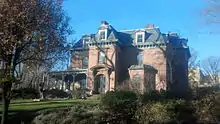William Fullerton (lawyer)
William S. Fullerton (May 1, 1817 – March 8, 1900), was a prominent New York lawyer of the 1860s to 1880s. Fullerton represented industrialists and political litigants, and was also well known for his representation of women in contested divorce cases. He briefly served on the New York State Supreme Court.
.jpg.webp)
Life and career
Fullerton was one of twelve children born to a farming family in Minisink, New York.[1] He worked as a school teacher and principal while attending Union College. A member of the class of 1837, he left college before graduating to study law with William C. Hasbrouck, and was admitted to the bar in 1840. He practiced in Newburgh, New York, and served as District Attorney of Orange County in the mid 1840s. After appearing in the same court case as Charles O'Conor, a prominent New York lawyer, O'Conor invited Fullerton to join his partnership in New York City.[2] When O'Conor served as United States Attorney for the Southern District of New York in 1853 and 1854, he employed Fullerton as an Assistant U.S. Attorney to prosecute criminal trials.
In August 1867, Fullerton was appointed to fill a vacancy on the New York Supreme Court, and he served until his successor was elected in November. The growth of railroads and corporations in the 19th century, and their excesses brought an explosion of litigation and other opportunities for attorneys.[3] The Erie War of 1868–69, for example, pitted Cornelius Vanderbilt and his legal team (including Fullerton) against Jay Gould and associates, with legal actions that kept both sides busy nearly around the clock.[4]
.jpg.webp)
Prominent cases in the 1870s made Fullerton a minor national celebrity. First, as a member of the defense team in the 1873 trials of "Boss" Tweed, his involvement in an effort to persuade Judge Noah Davis to recuse himself on grounds of prejudice led to Fullerton and others being censured and fined, despite Fullerton's presentation at a hearing that The New York Times would call "[one] of the most impressive proceedings ever witnessed in this city."[5] Francis H. Wellman called Fullerton the "Great American Cross-Examiner" partly because of his four days of cross-examining the orator and religious figure Henry Ward Beecher, in connection with Beecher's 1875 adultery trial.[6] The verbal jousting between Fullerton and Beecher was covered from coast to coast.[7]
In 1876, Fullerton teamed up with his brother, Judge Stephen W. Fullerton, in a sensational divorce case involving Robert H. Berdell, a former President of the Erie Railroad and a leading citizen of Goshen, New York. The lurid accusations as well as Berdell's business history brought national attention to the case. Although the Fullerton brothers were successful on Mrs. Berdell's behalf, the trial was followed a few months later by Berdell shooting and killing Wisner Murray, his former brother-in-law, who was the village President of Goshen. Associated litigation continued for nearly 20 years.[8]

Fullerton's career spanned more than 50 years and encompassed a wide array of high-profile cases. In 1885, he represented the Englishwoman Lucille "Yseult" Dudley, who had tried to shoot Irish nationalist Jeremiah O'Donovan Rossa [9]
Fullerton is commemorated at The Fullerton Mansion, which he built in Newburgh as a second home in 1868. He retired to it in the 1880s and lived there until his death. It is currently owned privately,[10] but available for community activities under the auspices of the Fullerton Cultural Center. Fullerton's only son, William Fullerton, Jr., was a composer who spent most of his adult years abroad. His death at age 34 put an end to a promising career.[11]
Fullerton died in 1900 at the age of 82 and is buried alongside his wife Cornelia (Gale) at Saint George's Cemetery in Newburgh.[12]
References
- "The Fullerton Family, Hon. Walter C. Anthony", Reprinted from the Historical Papers No. XIII of the Historical Society of Newburgh Bay and the Hudson Highlands, 1906
- "Death List of a Day, Ex-Judge William Fullerton", The New York Times, March 16, 1900, p. 7
- Pinansky, Thomas Paul. "The Emergence of Law Firms in the American Legal Profession", University of Arkansas at Little Rock Law Review, Vol. 9, Issue 4 (1986), Article 2, pp. 610–616. See, generally, White, Richard. Railroaded, The Transnationals and the Making of Modern America, W.W. Norton, New York (2011)
- Adams, Charles Francis, Jr. and Henry Adams. "Chapters of Erie and Other Essays", James Osgood, Boston (1871; reprinted by August M. Kelley, 1967)
- "Contempt of Court", The New York Times, November 30, 1873, p. 3
- Wellman, Francis H. "The Art of Cross-Examination", Ch. XI, Some Famous Cross-Examiners and Their Methods, MacMillan Company, New York (1903), pp. 155–159
- Applegate, Debbie. "The Most Famous Man in America", Three Leaves Press, Doubleday, New York (2006); and Green, Michael A. "Battle in Brooklyn: The Cross-examination of Henry Ward Beecher at the Trial of the Century", Judicial Notice: A Periodical of New York Court History, Issue 13, 2018, pp. 20–27
- "Divorce Goshen Style", Orange County Historical Society Journal, Vol. 44, November 1, 2015, pp. 2–9
- Green, Michael, "A Pistol Shot from across the Ocean", New York Archives, Vol. 15, No. 4, Spring 2016, pp. 22–26
- Farley, Jennifer. "Buying Stock in Newburgh: the Fullerton Mansion", Chronogram, January 1, 2013, pp.18–20, accessed November 28, 2013
- "In Memoriam", The Times, September 2, 1888
- "History comes to life in 2 cemeteries", Wallkill Valley Times, Times Community Newspapers of the Hudson Valley, September 17, 2009, accessed November 24, 2018